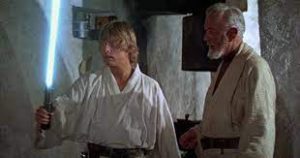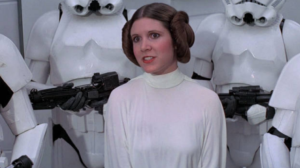12 Star Wars: A New Hope (1977)
Power and Oppression in Star Wars: A New Hope
by Thomas Koch
The pilot to the 4th-highest-grossing media franchise of all time, Star Wars Episode IV – A New Hope, retroactively rebranded from its original title Star Wars, is one of the most influential movies of all time. The 1977 sci-fi space western tells the story of a rebellion that stands up to the tyrannical galactic empire eventually defeating them in an epic final battle. Despite taking place in a fantasy universe with aliens and magic, Star Wars manages to accurately reflect real-life struggles with power and oppression. Although Star Wars speaks to many issues positively, it suffers from the same problems as many other movies of its time, the cast doesn’t have nearly enough diversity.
Growing up no other franchise dominated my screen time like Star Wars. Throughout my life, I have spent countless hours watching each of the films in the series. I chose to analyze this film because after hundreds of hours watching Star Wars, I decided that a deeper dive into the film could give me a new perspective on my favorite franchise. I chose to focus on the first film because it is where everything started and is therefore the most influential of the series.
Star Wars Episode IV – A New Hope is the story of a farm boy named Luke Skywalker who finds himself in the middle of a galaxy-wide conflict. At the start of the film, Luke is just a 19-year-old moisture farmer when he unintentionally receives a message from a distressed princess in need of help. Against the will of his guardian Aunt and Uncle, he finds Obi-Wan Kenobi, the man to whom the message was intended. Kenobi tells Luke that he is destined to be a Jedi like his father before him. Obi-Wan tells Luke that the Jedi are “guardians of peace and justice,” they wield magic powers attained through the force. Kenobi describes the force as “what gives a Jedi his power. It’s an energy field created by all living things. It surrounds us and penetrates us. It binds the galaxy together.” The duo eventually end up on an imperial space station rescuing the imprisoned Princess Leia and returning her to the home base of the rebel alliance with plans that would lead to the destruction of the planet-destroying Death Star.

In order to better understand the issues portrayed in the film it is important to understand the context of its creation. Star Wars creator George Lucas’ biggest source of inspiration for the conflict between the Rebellion and the Empire was the Vietnam War. The major conflict was still ongoing when Lucas began work on the story for the film. “The guerilla war waged by the Rebel Alliance against the Galactic Empire mirrored the battle between an insurgent force and a global superpower that was playing out in Vietnam as Lucas wrote Star Wars” (Klein).
The Vietnam War-esque conflict creates a power dynamic that many groups can identify with. This story resonates well with the Native American community in particular. The idea of small bands of underequipped rebels attempting to resist the tyrannical rule of the Galactic Empire lines up well with the real-life struggles that indigenous peoples faced with American colonialism. Despite having no on-screen representation many Native Americans still feel that their struggles are represented in the film. Darren Lone Flight, a member of the Three Affiliated Tribes in North Dakota says, “It’s a story a lot of our people [can relate to] as they’ve resisted colonial forces through history since contact” (Cram). The parallels between the Empire’s exploitation of resources and the historical exploitation of Indigenous lands and resources further strengthen the connection between the oppression of the Rebel Alliance and the Indigenous populations of the Americas.
Although the original Star Wars was ahead of its time in the visual effects department, it falls brutally short of that mark in the casting department. The cast of the film does not have a single non-white actor. The voice of Darth Vader was done by James Earl Jones, a black man, but the actor inside the suit is a white man. While it might be easy to write off any casting decisions as a product of the times, many movies in the 1970s featured black actors with movies like Shaft (1971) featuring black lead actors. The complete omission of non-white actors is unfortunately an inexcusable example of the all-too-frequent lack of diversity in Hollywood. Lucas allegedly intended to make Han Solo black and Obi-Wan Kenobi Asian and when asked why he didn’t he said “I didn’t want to make Guess Who’s Coming to Dinner at that point, so I sort of backed off” (Wetmore). This excuse, however, does not make up for the fact that the lack of racial diversity in a galaxy filled with hundreds of diverse alien species is a missed opportunity to create an inclusive universe and a movie truly ahead of its time.
On top of the clear racial diversity issues, the women in the film do not fare much better. The movie miserably fails the Bechdel test as the only two women in the film never appear in the same scene. Aside from Princess Leia the only other female with dialogue is Luke’s aunt Beru, who musters a mere 19 seconds of total dialogue in the film. Princess Leia immediately establishes herself as a strong female character by standing up to the Imperial officers and even Darth Vader who hold her captive. Unfortunately not even an industry-defining female lead like Carrie Fisher’s Leia is exempt from Hollywood sexism. Fisher famously reported that she was not allowed to wear underwear while in her costume because George Lucas told her, “There’s no underwear in space.” Neil Armstrong walked on the moon very much wearing underwear 6 years before filming for the movie began.

As one of the most popular and influential films ever created Star Wars Episode IV – A New Hope is undeniably a cinematic masterpiece and a massive success. The war-based conflict based on rebellion sets the stage for the representation of groups that have been or are currently facing oppression from a powerful entity like a government. Despite its success in this regard, the film falls short in the representation of people of color and women. Instead of capitalizing on the opportunity to create a fantasy universe that represents all people the film George Lucas chose to have no representation at all. In a world where diversity is celebrated, this film has been left behind, a product of its time or even worse.
References
Cram, Stephanie. “Colonialism and a Hopi Princess: Why Star Wars Resonates with Indigenous Audiences | CBC Radio.” CBCnews, CBC/Radio Canada, 30 Apr. 2020, www.cbc.ca/radio/unreserved/in-a-galaxy-far-far-away-exploring-star-wars-through -an-indigenous-lens-1.5420783/colonialism-and-a-hopi-princess-why-star-wars-res onates-with-indigenous-audiences-1.5422156#:~:text=Star%20Wars%20has%20ap peared%20as,tense%2C%22%20said%20Lone%20Fight.
Klein, Christopher. “The Real History That Inspired ‘Star Wars.’” History.Com, A&E Television Networks, 17 Nov. 2015, www.history.com/news/the-real-history-that-inspired-star-wars.
Wetmore, Kevin J. The Empire Triumphant: Race, Religion and Rebellion in the Star Wars Films. McFarland, 2005.

